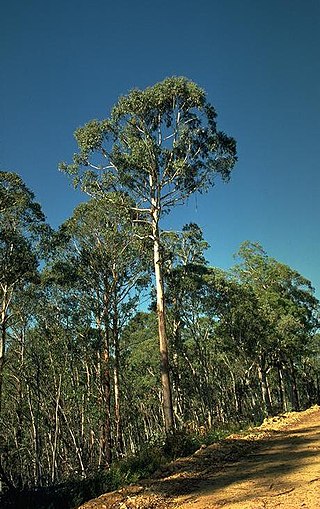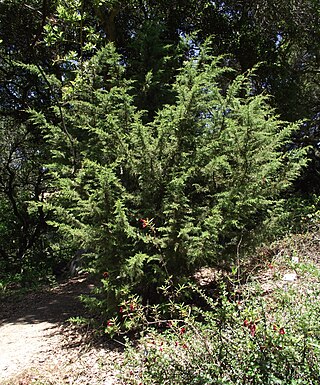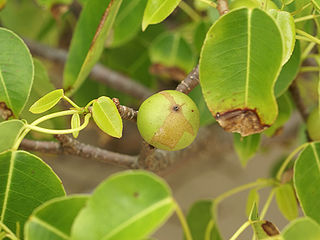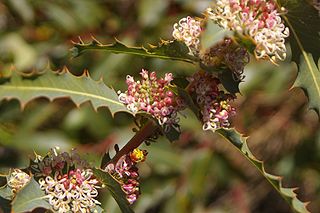
Curtisia dentata is a flowering tree from Southern Africa. It is the sole species in genus Curtisia, which was originally classed as a type of "dogwood" (Cornaceae), but is now placed in its own unique family Curtisiaceae.

Hesperocyparis macrocarpa also known as Cupressus macrocarpa, or the Monterey cypress is a coniferous tree, and is one of several species of cypress trees endemic to California.

Koelreuteria paniculata is a species of flowering plant in the family Sapindaceae, native to China. Naturalized in Korea and Japan since at least the 1200s, it was introduced in Europe in 1747, and to America in 1763, and has become a popular landscape tree worldwide. Common names include goldenrain tree, pride of India, China tree, and the varnish tree.

Eucalyptus delegatensis, commonly known as alpine ash, gum-topped stringybark, white-top and in Victoria as woollybutt, is a species of tree that is endemic to southeastern Australia. It has a straight trunk with rough, fibrous to stringy bark on the lower half of the trunk, smooth white bark above, lance-shaped to curved adult leaves, flower buds in groups of between seven and fifteen, white flowers and barrel-shaped or hemispherical fruit.

Anthocleista is a genus of tree- and shrub-like tropical plants in the subtribe Potaliinae in the Gentian family. There are between 14 and 16 species in the genus, native mainly to tropical Africa, including Madagascar and the Mascarene Islands. Anthocleista was once placed in the family Loganiaceae, but more recent molecular, morphological, and phytochemical evidence has placed the group well within the Gentianaceae.

Grevillea, commonly known as spider flowers, is a genus of about 360 species of evergreen flowering plants in the family Proteaceae. Plants in the genus Grevillea are shrubs, rarely trees, with the leaves arranged alternately along the branches, the flowers zygomorphic, arranged in racemes at the ends of branchlets, and the fruit a follicle that splits down one side only, releasing one or two seeds.

Hesperocyparis arizonica, the Arizona cypress, is a North American species of tree in the cypress family Cupressaceae, native to the southwestern United States and Mexico. Populations may be scattered rather than in large, dense stands.

Austrobaileya is the sole genus consisting of a single species that constitutes the entire flowering plant family Austrobaileyaceae. The species Austrobaileya scandens grows naturally only in the Wet Tropics rainforests of northeastern Queensland, Australia.

Hesperocyparis bakeri, previously known Cupressus bakeri, with the common names Baker cypress, Modoc cypress, or Siskiyou cypress, is a rare species of western cypress tree endemic to a small area across far northern California and extreme southwestern Oregon, in the western United States.

Hesperocyparis goveniana commonly known as Californian cypress and Gowen cypress, is a species of western cypress that is endemic to a small area of coastal California near Monterey. It was formerly classified as Cupressus goveniana.

Hesperocyparis guadalupensis, commonly known as Guadalupe cypress, is a species of western cypress from Guadalupe Island in the Pacific Ocean off the western coast of Mexico's Baja Peninsula. It was previously known as Cupressus guadalupensis until 2009. It is a medium-sized tree with fine green to blue-green foliage. In its native habitat it depends on water from the fogs that envelop high ground in the northern half of the island. It became an endangered species due to feral goats living on Guadalupe Island that – for more than a century – prevented new trees from growing. In 2005 the goats were finally removed from the tree's island home as part of an island restoration project. New trees are growing and other plants are beginning to recover, though the future of the species is not yet assured. Guadalupe cypress is closely related to the vulnerable Tecate cypress, which grows on the mainland in Baja California and southern California. It is used as an ornamental tree in Mediterranean climates, particularly in Europe, but has no other significant human uses.

Xylomelum is a genus of six species of flowering plants, often commonly known as woody pears, in the family Proteaceae and are endemic to Australia. Plants in this genus are tall shrubs or small trees with leaves arranged in opposite pairs, relatively small flowers arranged in spike-like groups, and the fruit a woody, more or less pear-shaped follicle.

The manchineel tree is a species of flowering plant in the spurge family (Euphorbiaceae). Its native range stretches from tropical southern North America to northern South America.

Hakea amplexicaulis, commonly known as prickly hakea, is a shrub endemic to south west Western Australia. An attractive small shrub with unusual stem clasping, sharply serrated foliage and a profusion of sweetly scented variable coloured flowers from late winter to spring.

Melaleuca ericifolia, commonly known as swamp paperbark, is a plant in the myrtle family, Myrtaceae and the genus Melaleuca, native to south-eastern Australia. It is a rather variable species and some specimens resemble Melaleuca armillaris but its papery bark and smaller, more prolific flower heads distinguish it from that species. It often grows in swampy areas and the draining and clearing of these has reduced the numbers of the species, especially around Port Philip Bay near Melbourne. It is also similar to Melaleuca pustulata, a Tasmanian endemic, but that species only grows in dry heath.

Leucopogon amplexicaulis, commonly known as beard-heath, is a species of flowering plant in the heath family Ericaceae and is endemic to eastern New South Wales. It is a scrambling or straggly shrub with egg-shaped, stem-clasping leaves with hairy edges, and spikes of small white flowers.

Malaxis seychellarum is a species of orchid endemic to the Seychelles Islands in the Indian Ocean. First described in 1902, it is now considered a vulnerable species.
Euphorbia amplexicaulis is a species of flowering plant in the family Euphorbiaceae and is endemic to the Galápagos, where it mainly grows in seasonally dry areas. It was first formally described in 1847 by Joseph Dalton Hooker in the Transactions of the Linnean Society of London.
Anthocleista madagascariensis is a species of plant in the Gentianaceae family. It is a tree that is widespread throughout the evergreen forests of Madagascar.
Anthocleista djalonensis is a species of plant in the Gentianaceae family. It is a small tree that is found from West Tropical Africa to South Chad.

















